
JS:
I chanced upon this recipe for "Deep Fried Fish, Suzhou Style" while browsing through Pei Mei's cookbooks.
Being food-obsessed, it seems like I hardly read anything else anymore. If the book isn't about cooking or food and/or does not have any pictures of food, my eyes start to glaze over and my mind starts to wander. ;)
Suzhou?
Hm, didn't I read something about Suzhou being a sub-branch of Jiangsu cuisine?
Oh, why yes, Suzhou is indeed one of the three sub-branches, along with Wuxi and Nanjing, of Jiangsu cuisine.
This is the final (at least, final for now!) recipe from our Jiangsu series, to coincide with the second installment of Chowtimes' Eight Great Traditions of Chinese Cuisine (8GTCC) dinners. The second dinner is done and I can't wait for the next one.
For more information on Jiangsu cuisine, visit our Wuxi Pork Spareribs post.
about Fu Pei Mei
http://www.flavorandfortune.com/dataaccess/article.php?ID=379
http://tofuwatch.com/2009/07/decades-later-fu-pei-meis-chinese-recipes-particularly-tofu-still-inspire-who-was-she/
Pei Mei cookbooks
Squirrel Fish (松鼠鱖魚)
JS:
I knew I wanted to get a fish dish in as one of our recipes and perhaps the most well-known fish dish in Jiangsu cuisine is 松鼠鱖魚, usually translated as Squirrel Fish.
Don't worry, no actual squirrels are harmed in making this dish. This is a fish that is deboned, the flesh cut in a cross-hatch pattern to look like a squirrel in flight, then fried, and served with a sweet and sour sauce.
Like a lot of Chinese dishes, there is a story behind the dish "Squirrel Fish."
Apparently, a long time ago, an Emperor wanted to eat carp, but for some reason -- I'm not too clear about the reason -- carp was verboten. Of course, being the Emperor, he wanted to get his way. His chef then had to devise a way to make the carp un-carplike, using his kitchen techniques to make the fish look like a flying squirrel instead.
http://www.tastejiangsu.com/activities/food.html
We were served a version of this at our Jiangsu dinner at Shanghai Village, although Chef Ming's fish looks more like a dragon than a flying squirrel. In his more grandiose interpretation of the dish, he even included foam (from egg whites, I assume) to masquerade as clouds.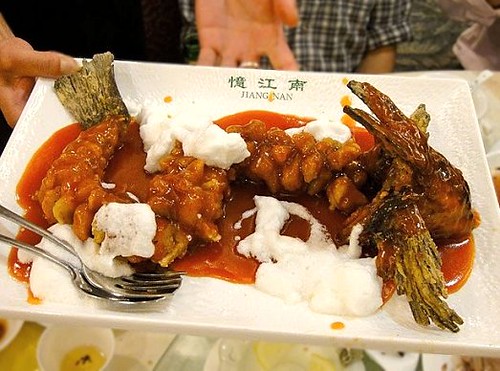
Squirrel Fish (or, "Dragon in the Clouds" Fish) at Shanghai Village
photo by fmed
urbanspoon: Shanghai Village (Vancouver, BC)
JS:
As you can see from the intricate knife work involved, Squirrel Fish is a tad ambitious. Plus, TS is not too crazy about fish in sweet and sour sauce, to the point of dislike. I'm not too crazy about fish in sweet and sour sauce either, but I'm only to the point of indifference.
So onwards to "Deep Fried Fish, Suzhou Style" as something that is more manageable within our limitations and inclinations.
Suzhou Smoked Fish is not smoked!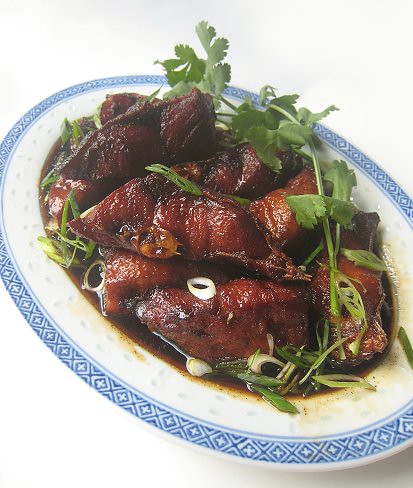
TS:
Just a note about the name of this dish. It is actually called 蘇州燻魚, which means "Suzhou Smoked Fish". JS originally did not want to call our dish such, as we did not smoke the fish for our version.
But then, I wanted to confirm that she provided the correct Chinese name for this dish, since she originally wrote down 蘇式油炸魚, meaning "Deep-fried Fish in the style of Suzhou". After intense googling, made more challenging by a language barrier, I have discovered that Suzhou Smoked Fish is not smoked at all!
First, a Squirrel Fish, now a non-smoked Smoked Fish! Those wily Chinese!
Perhaps JS and I are late to the party, because apparently, this fact is "known", as attested by mmm-yoso's posts describing this "smoked" dish (here and here).
JS:
A little research yielded the story behind Squirrel Fish. I don't know what the story is behind the non-smoked smoked fish though. Perhaps somebody can chime in?
TS:
Curiouser and curiouser.
Anyhow, here's how to make this non-smoked Suzhou Smoked Fish. It's so simple that you'll wonder at the length of our introduction.
JS:
I chose grass carp for this dish. I had originally wanted to do halibut, but decided against it because halibut flesh might be too firm for this application. I wanted a meaty fish but with some give. I took home about 2 pounds of grass carp steaks.
Since the fish was already in steaks, I cut up each into four sections instead of slicing the fish thinly. I didn't bother taking out the bones as I was afraid that the fish might fall apart without them.
The first step is to marinate the fish with some soy sauce, Shaoxing wine, green onions and ginger for 30 minutes. Wine, green onions, and ginger are often used with fish as it is believed to combat the "fishiness" of fish. In some Western recipes, soaking fish first in milk is supposed to achieve the same result.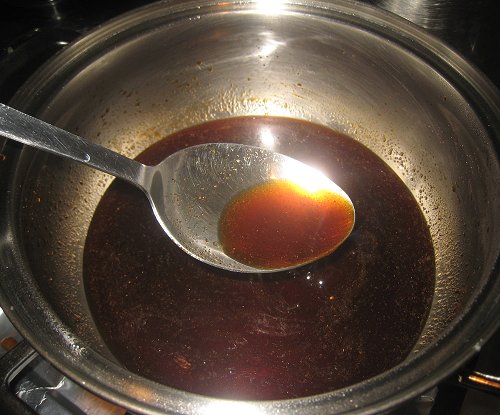
JS:
In the meantime, I made the Suzhou-style sweet-and-salty sauce.
This is a very simple sauce consisting of soy sauce, sugar, water, a pinch of five-spice powder, and a few droplets of sesame oil. The flavour should be a balance of salty and sweet, tipping a couple of points towards the sweet side if you have to err. It was brought to a boil and simmered on low.
deep brown fried fish, ready to be soaked
JS:
After the fish had marinated for some time, it was a simple fry job. The fish pieces were fried until they're done and a deep brown colour.
When they're good and fried, we soaked them in the Suzhou-style sweet-and-salty sauce. We soaked ours for about 5 to 8 minutes a piece and took them out after to prevent them from getting too soaked and soggy. This is a longer soaking time (longer than 1 to 3 minutes) because our fish pieces were thick.
When it came to serving the fish, we drizzled the sauce over the fish. The sauce is delicious after being infused with the fried fish. Or is it the other way around? Is it the fish is delicious after being soaked in the sauce?
Anyhoo, which is infusing which doesn't really matter. This dish is fantastic.
Again, as with the other Jiangsu dishes, this is an instant hit with the family. We served it more as a "viand" (or ulam, to be eaten with rice), with the sauce included, rather than an appetizer, which is usually sans sauce.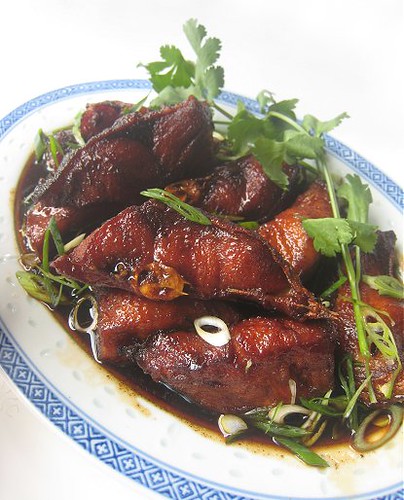
JS:
This sauce is the same type of sauce that was served with the Spot Prawns dish we had at the 8GTCC Shanghai Village dinner. Definitely a keeper sauce with seafood.
Actually, it also works fantastically with crispy fried chicken. The method is the same: marinate the chicken pieces in the marinade (4 to 6 hours or overnight if possible), fry your chicken pieces, then soak in the sauce when done. Serve chicken pieces with sauce and eat with rice.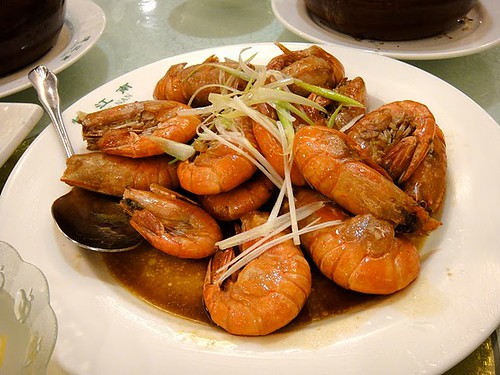
Prawns at Shanghai Village
photo by fmed
By the way, thanks again to fmed for letting us use his photos from the Shanghai Village dinner. Thanks, fmed!
eatingclub JiangZhe dishes
Jade Tower ( 翡翠塔), or Tofu with Aster Indicus (香乾馬蘭頭)
Wuxi Pork Spareribs (無錫排骨)
"Little Cubby Heads", Lion's Head Meatballs (小獅子頭)
Supreme Lion's Head Meatballs with Crabmeat (清燉蟹粉獅子頭)
Suzhou Deep-fried Fish, or Suzhou Smoked Fish (蘇州燻魚)
Enjoyed this post? Why not subscribe to our blog? Subscribe via reader or subscribe via email. Thank you! |
Recipe
Suzhou Smoked Fish (蘇州燻魚)
adapted from the recipe for "Deep Fried Fish, Suzhou Style 蘇式燻魚" in Pei Mei's Chinese Cook Book Volume I
2 pounds grass carp steaks, cut into quarters
Marinade
4 stalks green onions, white parts only, cut into slivers
3" piece of ginger, cut into slivers
2 tbsp Shaoxing wine
4 tbsp soy sauce
2 tbsp water
Soaking sauce
8 tbsp soy sauce
1/2 cup brown sugar
1 cup water
1 tsp five spice powder
1 tsp sesame oil
Marinate carp pieces with marinade ingredients for 30 to 45 minutes.
In the meantime, in a separate pot, mix together ingredients for the soaking sauce. Bring to a gentle boil and put on simmer.
Fry fish pieces in oil until deep brown. Put fried fish pieces in the soaking sauce. You can take the fish out after five to eight minutes to prevent them from getting too soggy.
To serve, arrange fish pieces on a plate and drizzle with sauce, if desired. Garnish with green onions. Enjoy.






I love a Taiwanese style "smoked" fish...I wonder how similar or different it is. I don't know how to make it but mom does so better find out. =)
ReplyDeleteMy Chinese friend told me about smoked fish in Shanghai and it is similar to what you have here.
ReplyDeleteI'm pretty sure that my Mom has a few Pei Mei cookbooks kicking around from the early 1980s, and I really need to go dig them up! Every Pei Mei inspired post you do looks SCRUMPTIOUS. Oh yes, and I loved the fish with black bean, by the way. Thank you again, so very much, for taking the time to send on all that information!! It was put to delicious use and very appreciated :)
ReplyDeleteJessica@FoodMayhem:
ReplyDeleteOh, I don't think I've heard/seen/eaten Taiwanese-style smoked fish. Is it actually smoked? Although, we did use Pei Mei's recipe, more or less, so perhaps that has a Taiwanese slant to it already. Hmmm.
tigerfish:
Woohoo! So we don't have it all wrong. =D
CB Tina:
Really?! Wow. Yes, do go dig them up!
No problem! I'm just glad you liked it and didn't go, "What kind of useless information and recipes is TS giving us?!?" =)
I've always wondered about this because it tastes deep-fried to me. And so it is! :P
ReplyDeleteWandering Chopsticks:
ReplyDeleteChinese people and their tricky ways! ;D